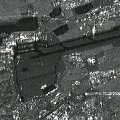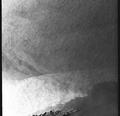
The Antarctica 2003 expedition - Background


In the very high latitudes of the Earth, cloud cover is very frequent, and this is why we have so little information for those remote areas in spite of satellite observations. In fact, many Earth-observing satellites take pictures in the visible and infrared bands, and what we see on these images are mostly banks of clouds. Moreover, only the summer months can be used for optical imaging. In winter, these landscapes are plunged into complete darkness. This changed with the arrival of radar-carrying satellites. Since the launch of ERS-1 in 1991, a wealth of data from both polar regions has been available. And since 2002, Envisat monitors this icy world even more frequently in 400 km-wide strips.
Radar are active remote sensing instruments that send out microwave pulses and receive their echoes. Very large computing power is needed to evaluate these echoes and to produce a radar image. Since microwave penetrates clouds, we always have a perfect view of the Earth's surface. In addition, microwaves penetrate vegetation and dry soil as well as dry snow. But radars cannot see under water.
 |  | | |
This ERS radar image shows an airport, roads, buildings and grassland
|
The information we see on a radar image has nothing to do with colours, as is the case in photography and optical satellite imagery. On radar images we see the surface structure, and more specifically, the roughness of the surface. But what does 'rough' mean? What is a rough surface? For the ERS and the Envisat radar, grasslands, meadows, and pasture represent smooth surfaces, while woodlands and towns have rough or even very rough surfaces.
 |  |
Radar image from a coastal image
| |
You can observe surface roughness very well on water bodies, such as on a pond, a lake, or the sea. With no wind, the surface is calm and in terms of radar response it is smooth (little or no response). On a windy day we see waves, the height depending on the wind speed, and for the radar this is a rough or very rough surface. A lot of radar energy is backscattered, and on the image this area appears bright. The brighter the image, the higher the wind speed. Now you can answer the following question: in which grey level do grassland, highways, runways and calm water surfaces appear on an Envisat radar image?
In a very dark grey level, of course!
 |  | | |
One of the largest glaciers of Antarctica: the Lambert glacier
|
As you can see, radar pictures are just black and white. A white area means that the surface is rough, whereas a darker area represents a smooth surface. But our images of Antarctica are taken in a strange world, unknown to most of us, of mostly ice and snow. In order to be able to interpret these images, we need to understand how the microwaves transmitted by the radar will react to this surface.
The surfaces we expect to encounter are made of snow, ice, rock, gravel and other bare soil and water. We've already explained what 'roughness' means for water, and how the radar waves will react to it. Little or no wind will result in a smooth water surface and will be dark on the radar image, whereas high waves will produce a rough surface and appear bright. Rocks will appear mainly bright, whereas gravel of small pebbles and muddy bare soil will appear black. For snow and ice, the matter is more complex, because microwaves penetrate very dry snow and ice. This means we can get information not only from the surface but also from the volume.
 |  |
ASAR image of Antarctic coast, acquired 21 November
| |
In the polar regions, the surface is frozen most of the year, and is therefore dry. It consists of deep, well-pressed snow packs that are slowly transformed into ice, without melting. This process is observed in permanently very cold environments, and is referred to as the 'metamorphosis of snow crystals'. The higher part of Antarctica is frozen all year long. This part appears dark in the images. Microwaves penetrate deeply and are finally absorbed.
Dry snow in lower parts and at the sea level of Antarctica appears mainly bright because of freezing and melting. This creates ice lenses, which are small layers of ice, inside the snow pack. These lenses are responsible for the strong radar response and hence the bright appearance that we can observe in the images. However, also in low areas, a dark zone can be observed. This is made of either bare soil or wet snow. Both have a smooth surface, and due to the high liquid water content, no penetration is possible.
Rather complex is the situation of the sea, where we have many different types of ice and open water, or just smaller or larger linear openings, known as leads.
The ice, which is mostly sea ice, appears in many different forms, ranging from very small pieces to ice floes and giant icebergs. We must also consider the wind and the current that move the ice around and pile it up, and in doing so, change the form of the pack ice and hence our radar signal.
But let's simplify the interpretation of the images and just go through the most important sea ice types. We will also assess the problems that the ice might cause to navigation.
 |  |
Example of interpretation of different ice types
| |
Sea ice types
- Grease ice: a soupy layer of ice in the stage of formation, it smoothens the water surface and makes it become dark on the radar image, like an oil film (in fact it can look like oil pollution, although it isn't).
- Shuga: accumulation of spongy ice lumps. It has a similar aspect to grease ice but smoothens the water surface even more. It often appears as wind-driven long dark bands, while the water around it would be bright due to the wind-driven waves. Huge waves of a swell are sometimes easily visible in such zones. It poses no problem to icebreakers.
- Pancake ice: patches of ice up to 2 metres in diameter with raised rims. Such ice zones appear bright in the radar image. The swell can travel through this ice type and one can see long waves. Icebreakers cross it easily.
- Grey ice, first year ice: large ice floes, often pushed into each other by wind. It mostly appears dark grey on a radar image. The swell can hardly move the ice up and down. Icebreakers usually cross it.
- Medium to thick first year ice: while the former ice types assume the temperature of the water, medium or thick first year ice is mostly thicker than 70 cm and therefore isolates the water from the air. The surface of these mostly large floes is rather rough, and appears bright in a radar image. Icebreakers crossing it must work hard and therefore tend to navigate around larger floes.
- Fast ice: fast ice or land fast ice is also first year ice found near the coasts. This ice type is very smooth and hence dark in the radar image. A penetrating ship leaves a trail behind. Often icebreakers need to cross it in order to reach research stations on shore. It might be hard for an icebreaker to pass through it.
- Second and multiyear ice: sea ice many metres thick, often forming huge ice floes or, if nearly melted, forming small icebergs. Large floes show some structure, refrozen cracks, etc. In the radar image, they are of medium to strong brightness, but in the summer they might appear with dark patches of meltwater ponds or wet snow. Icebreakers avoid it and careful navigation is necessary.
 |  |
ASAR image of 20 November 2003
| |
- Giant ice floes and tabular icebergs from calving glaciers (not sea ice): huge floes, ten to over a hundred metres thick. Their surface might be many hundreds of square kilometers large, and apprear bright or dark, depending on the age, the surface cover, and the ambient temperature. They all have a bright edge and a dark edge. The bright edge is the ice wall looking toward the radar (the radar always 'looks' not vertically but to the right side of the direction it is moving in the orbit). The dark edge is the wall looking away from the radar illumination. Smaller icebergs are seen as bright points. Giant tabular icebergs can live many months and can also travel to lower latitudes. All ice pieces are really dangerous for ships - remember the Titanic! Icebreakers avoid, by all means possible, being in their vicinity!
The minimum size of icebergs to be detected by radar depends on the size of ice above the water, the spatial resolution, and the 'background'. If the sea is calm around it, an iceberg the size of a small house (above the water) would probably be visible on a high-resolution radar image (25 metres). In a wide swath medium resolution image (150 m) the iceberg needs to be a bit larger but not that much. In stormy seas, small icebergs do not stand out from the background, and they can go undetected, but icebergs that are more than 500 metres can be seen.
All these indications will help us interpret radar images taken in the vicinity of the Arctic and Antarctic regions.
Last update: 18 April 2013

 |  | 
Antarctica 2003 expedition

| | • | Introduction (http://www.esa.int/SPECIALS/Eduspace_Global_EN/SEMVG70YDUF_0.html) |  | 
Exercises

| | • | Introduction (http://www.esa.int/SPECIALS/Eduspace_Global_EN/SEM1V70YDUF_0.html) |  | | • | Exercise 1 - Accompany a classmate (http://www.esa.int/SPECIALS/Eduspace_Global_EN/SEMNX70YDUF_0.html) |  | | • | Exercise 2 - Guide the icebreaker through the ice using images and maps (http://www.esa.int/SPECIALS/Eduspace_Global_EN/SEMFDC0YDUF_0.html) |  | | • | Exercise 3 - Guide the icebreaker through the ice using a computer (http://www.esa.int/SPECIALS/Eduspace_Global_EN/SEM0HC0YDUF_0.html) |  | | • | Exercise 4 - Help, the icebreaker is stuck! (http://www.esa.int/SPECIALS/Eduspace_Global_EN/SEMJ7G0YDUF_0.html) |  |

|

